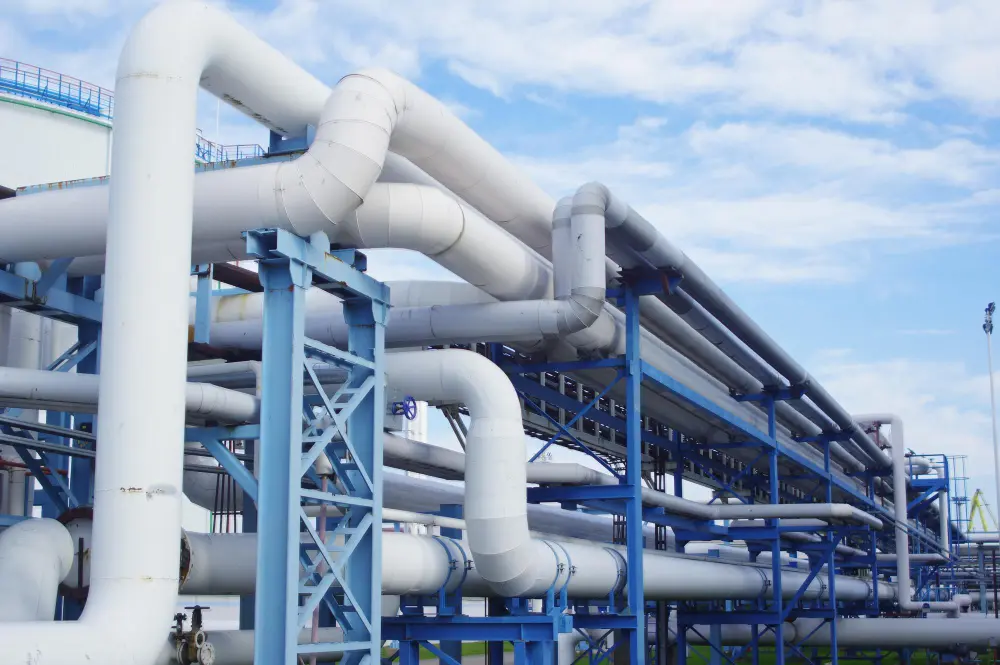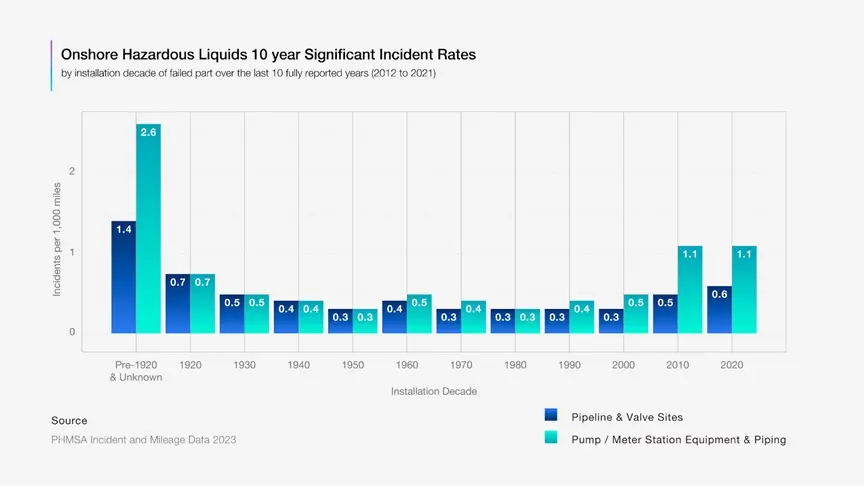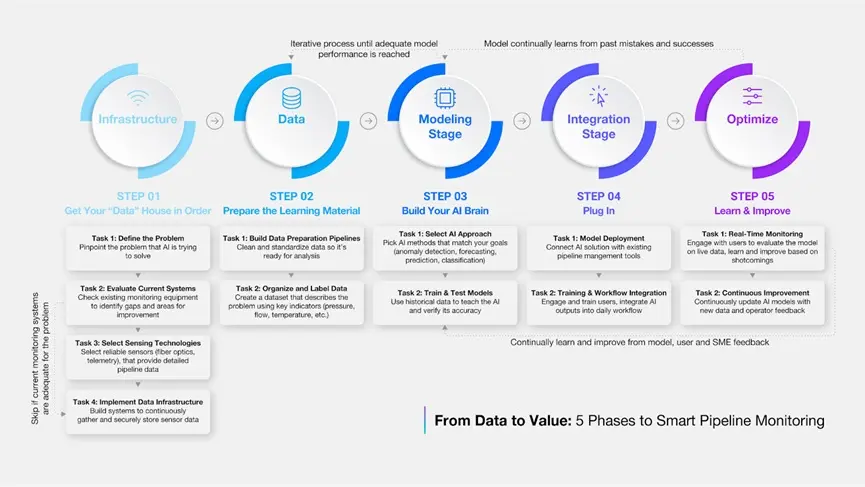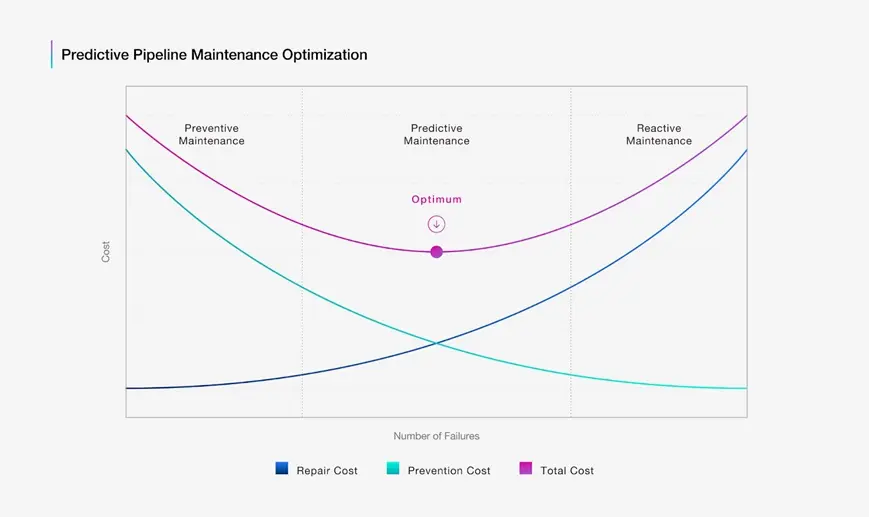•
Jun 24

Sand Technologies
The importance of pipeline transportation cannot be overstated. Oil and Natural Gas are transported through pipelines because it’s the most efficient, economical and reliable way to move large volumes of these resources over long distances. Pipelines minimize energy use and reduce transportation costs more than other methods. However, half of the U.S. pipelines are approaching or have already exceeded their 50-year lifespan. And, more than 72% of pipelines in Europe exceed 40 years of age. This reality is a concern because older pipelines are more prone to leaks and failures.
Yes, generally, oil and gas pipelines are safe and efficient for transporting energy products. They are a safer alternative to other transportation methods, such as trucks, trains, or ships. Pipelines are a highly efficient and reliable method for transporting large volumes of energy products over long distances. The U.S. Department of Transportation’s Pipeline and Hazardous Materials Safety Administration (PHMSA) regulates pipelines, working with state partners to ensure safety. However, accidents can and do occur.
According to the Pipeline Safety Trust, the incident rate per 1,000 miles rises dramatically in pipelines at the beginning and end of their lifecycle. Older pipelines experience a higher incident rate, rising to 2.6 incidents per 1,000 miles, compared to newly constructed pipelines, which have an approximate rate of 1.1 incidents per 1,000 miles. Pipelines in the middle of their operational lifecycles, although lower, still maintain a consistent incident rate of around 0.4 incidents per 1,000 miles.

When pipelines carrying crude oil or natural gas leak or rupture, the released materials often combust, causing dangerous explosions that threaten nearby personnel and communities. These incidents can result in severe burns, injury from explosion shrapnel and extensive property destruction, highlighting the human cost of inadequate pipeline integrity management.
The oil and gas pipeline industry has established ambitious safety goals, working toward zero incidents. Enbridge and Shell both explicitly pursue a goal of zero incidents across their pipeline networks. Shell’s “Goal Zero” initiative, which aims for “no harm and no leaks,” has led to a significant reduction in equipment downtime costs within the oil and gas industry.
Beyond immediate cleanup and repair costs, incidents also generate indirect and long-term economic consequences, including a negative brand reputation, public relations challenges and increased legal fees. Pipeline failures devastate ecosystems by releasing contaminants into soil, water and air, potentially contaminating aquifers, soil and water bodies. For instance, the 2010 San Bruno gas pipeline explosion led to Pacific Gas & Electric facing $1.6 billion in penalties. Total fines and settlements from that incident have exceeded $2 billion, illustrating the severe financial risks associated with pipeline failures.
AI-driven digital solutions and advanced technologies are revolutionizing many aspects of the oil and gas value chain, from energy procurement to pipeline asset health management. Integrated pipeline management frameworks encompass inspection, prevention, management and rehabilitation to ensure safe, compliant and efficient operation.
Digital preventative maintenance tools enhance asset management across the pipeline lifecycle. Advanced analytics processes vast amounts of inspection and monitoring data to identify subtle patterns that indicate integrity threats, providing powerful tools to maintain asset health, enhance safety, reduce environmental risks and optimize economic performance.
Unplanned downtime can cost an average of $34 million for most oil and gas companies, with some companies incurring costs as high as $87 million annually. As a result, across all heavy asset industries, maintenance practices are shifting from a reactive to a predictive maintenance strategy.
AI has become a powerful ally to industries with heavy assets. The technology can parse large datasets in real-time, compare them to historical data, and quickly identify deviations in baseline metrics. As a result, AI solutions can provide various cost-saving benefits in the oil and gas industry. These benefits are outlined below.
AI algorithms analyze IoT sensor data in real time to detect early signs of wear. Through advanced machine learning algorithms, AI identifies patterns and anomalies in asset performance data, allowing companies to address potential equipment failures before they occur. Early detection enables timely interventions that avoid unplanned shutdowns and costly repairs. These advanced algorithms analyze real-time data streams from machinery and infrastructure to identify subtle patterns and anomalies, which human operators and traditional methods often miss.
Early detection enables predictive maintenance benefits, such as reducing the risk of costly equipment failures and unplanned downtime, and ensures a safer working environment for technicians. With AI-driven insights, companies can optimize asset performance, extend equipment lifespan and operate with greater efficiency and reliability, providing a competitive edge in the industry. For instance, Shell reported the following results of using AI-powered predictive maintenance:
AI-powered pipeline asset health solutions offer a clear, quantifiable impact across safety, cost, and operational efficiency. The ability to continuously analyze real-time sensor readings and compare them to historical maintenance data enables AI systems to proactively uncover potential failures and optimize maintenance workflows. The table below summarizes the key benefits organizations can expect when transitioning from reactive or time-based strategies to a predictive, AI-driven approach.

Considering the benefits outlined above, companies should adopt a data-to-value approach and follow the five phases below to achieve smart pipeline monitoring.
To prepare the learning material, start by building data preparation pipelines to clean and standardize data, making it ready for analysis. Next, organize and label data. Think about creating a dataset that defines the problem using key indicators (pressure flow, temperature, etc.). For monitoring assets such as extensive infrastructure, remember that unstructured data types, like video, can provide superior insights.
Improve the model with real-time monitoring. Engage with the users to evaluate the model on live data, and learn and improve based on any model shortcomings. Continue to train the AI model with new data and operator feedback.
Five Critical Phases to Deliver an AI Pipeline Solution

Once the infrastructure is established, the journey to smarter pipeline monitoring involves iterative and continuous improvements across all phases. Throughout solution development, iteration occurs between the modeling and data phases. Think of AI as a brain and data as its library of study materials. Model experiments guide improvements in the data, refining the learning material for the “AI brain.” A brain can only learn from the data it has. Better source material results in a smarter and more sophisticated brain.
Initially, when historic data is limited, advanced analytics provide valuable insights. However, true AI capabilities depend on a robust library of data and historical examples from which it can learn and draw insights. As the system accumulates more data and detailed labels (examples) for the model, the “AI brain” can learn increasingly sophisticated patterns, eventually surpassing traditional, rule-based approaches. This capability enables companies to solve multiple complex problems at a higher rate with better accuracy.
Implementing AI solutions, such as predictive maintenance tools for pipeline health monitoring, represents a significant shift toward proactive asset management. Predictive maintenance, a cornerstone of this approach, offers substantial value by ensuring maintenance is performed precisely when needed, avoiding unnecessary preventive actions, and minimizing costly reactive repairs. By accurately forecasting failures, predictive maintenance reduces overall operational costs, enhances reliability and maximizes asset uptime, resulting in optimal maintenance efficiency.

By adopting a structured approach, companies can significantly improve their ability to identify and address pipeline issues before failures occur. Preventive maintenance benefits include reduced environmental risks, enhanced regulatory compliance, lower maintenance costs and extended pipeline lifespans. Getting executive sponsorship and maintaining clear communication are essential to securing resources, breaking down operational and data silos, and aligning AI initiatives with broader business objectives.
As AI technologies evolve, organizations establishing robust foundations today will be well-positioned to leverage future advancements. Although implementation demands significant investment, the substantial returns, including prevented failures, reduced downtime and optimized maintenance, make adopting AI a strategic imperative for forward-thinking pipeline operators.
Other articles that may interest you